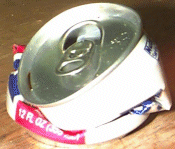1. The Court
|
Zorkball is played on an open grassy field, within which is found a
traffic or street sign fastened to a metallic signpost.
The field should be adjacent to a concrete sidewalk with a
curb. All ground beyond the curb is "out of bounds."
|
2. The "Hez"
|
A circle three-meters in radius, and with the signpost at its
center, is marked (typically, by a rubber garden
hose) on the grass.
The area of the court within this circle is known as the "hez."
|
3. The Zork
|
An aluminum soft drink can (preferably Dr. Pepper) is crushed vertically
by sudden application of foot pressure, forming the zork. The zork should
be as symmetrical and as compact as possible, and should hopefully
be free of sharp edges.
|
4. The Teams
|
Two teams of two players each compete.
|
5. The Object
|
The object of a game of Zorkball is to have more points than the
opposing team at the end of twenty minutes of play. If neither
team outscores the other, the game ends as a tie and counts as one-half
win for both teams.
|
6. Scoring
|
If either member of a team causes the zork to contact the
signpost, that team is awarded one point. Additionally, if
either member of a team commits any penalty, one point
is awarded to the opposing team.
|
7. Play
|
To begin play, one team (the team which lost the most recent untied
game played between the two teams, or, failing this, the team with the
worse record, or, if both teams are tied in the standings, the
"visiting" team) takes possession of the zork on the grass at some
distance away from the post. Both teams then endeavor to cause the
zork to contact the signpost. Whenever a point is awarded, the team
not receiving the point re-starts play in similar fashion.
|
8. Chipzorking
|
If either member of a team causes the zork to go out of bounds, the
opposing team is immediately awarded a "chipzork." One member of
the chipzorking
team places the zork on the upslope of the curb and kicks it back
into the field of play.
If a chipzork contacts
the signpost or the
sign before touching the ground, a point is awarded.
(Only during a chipzork does zork-contact with the sign itself
merit a point. Otherwise, points are awarded only for contact
with the post.)
|
9. Penalties
|
If any player commits any of the following six penalties during play,
even if accidentally, the opposition is awarded one point and play
re-started as described in Rule 7:
|
Two-Handing
|
Having both hands simultaneously in contact with the signpost.
|
Handzork
|
Contact of the zork with the hand either:
- while the player is in contact with the ground within the hez, or
- while in mid-air and when the player's most recent and his
next contact with the ground is within the hez.
|
Walking
|
Holding the zork in the hands continually through a change of position
from one location on the ground to another. A player may move
one foot if the other remains stationary throughout his entire possession
of the zork. A player may also leave the ground with both feet as long
as possession of the zork is given up before he once again comes in contact
with the ground.
|
Delay
|
A delay penalty is called against a team when a count of ten (approximate
seconds) is reached by the opposition. Such a count begins at the
counting team's discretion, and delay is called if ten is reached
in any of the following circumstances:
-
If a player does not, through the count of ten, release the zork from
his hand or from beneath his foot, or
-
If a team, in possession of the zork out-of-bounds, refuses
throughout the count of ten
to take a chipzork attempt to which that team is
entitled, or
- If the zork is sent far from the action and
the team that last contacted the zork does not reach it through
the opposition's count of ten.
Note that if this count is begun while the zork is out of bounds, and if
the team that sent it out of bounds is successful in reaching the zork
before ten is counted, that team is awarded the chipzork.
|
Interference
|
Interference is called on a chipzork attempt when either:
- an opposing player is out-of-bounds or on the sidewalk when the
chip is taken, or
- an opposing player contacts the zork with his hand before the zork
contacts the sign, the post, a member of the chipping team, or the
ground.
|
Eastwooding
|
Physically restraining another player from play either by:
- embracing, grasping, or holding the player,
- tackling the player to the ground,
- refusing to yield possession of the zork to a team for that team's
chipzork attempt,
- stomping on the player's foot while wearing hiking boots, or
- in any manner forcibly causing the player to commit what would
otherwise be a penalty
|
10. Match Play
|
Zorkball is played in matches of five games (all five of which are
always played). A match may end up tied at two and one-half games
apiece, in which case it is awarded to the
team having scored more points during the match. If both teams
have scored the same number of points during the match, the match
is tied, and both teams are awarded one-half of a match victory in
the standings.
|
11. Rankings
|
Team standings in a Zorkball league or tournament are determined by
number of matches won.
Ties in the standings are broken by number of games won, and then
by number of points scored.
|
